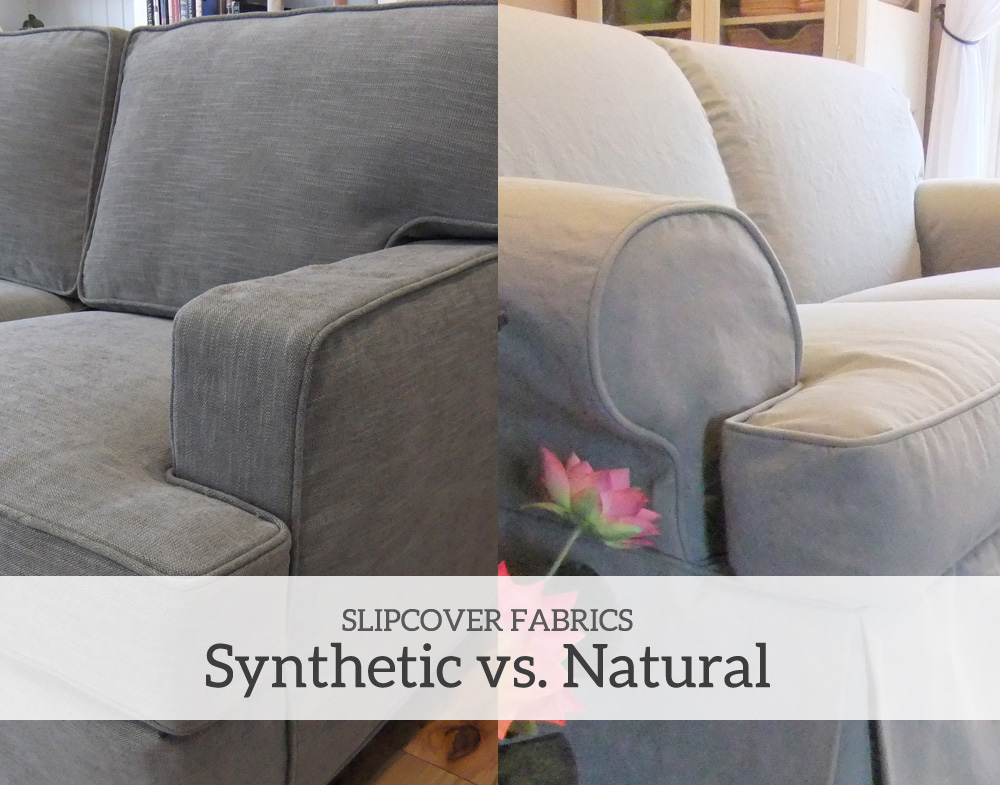Are Performance Fabrics a Good Choice for Slipcovers?
Scroll through my list of favorite fabrics and you will find plenty of natural fiber options that work great for indoor slipcovers.
What you won’t find are synthetic performance fabrics, the kind that resist stains or repel moisture and/or protect against fading from sunlight.
Why? For me, It’s matter of personal choice and boils down to this:
- I think a slipcover made in a good quality cotton denim, cotton canvas, linen or hemp looks much more beautiful and feels so much nicer than a synthetic version.
- I don’t have a need for fabrics that are chemically treated to guard against spills, grime and dog slobber. Stains don’t freak me out. If my slipcovers get dirty I just throw them in the wash with or without a laundry booster. It’s easy.
- I discovered during my career as a textile developer that I’m not able to tolerate working with fabrics that are chemically treated. Performance fabrics wreak havoc on my health.
But just because I don’t use treated synthetic fabrics for slipcovers doesn’t mean they are a bad option for you. Like I said, it’s a personal choice.
When considering synthetic versus natural fiber, decide on the look & feel you’re going for, how you want your slipcover to perform and how much you are willing to spend.
Here are 5 things to keep in mind:
1. Just because it’s polyester doesn’t mean it naturally resists stains and moisture. Untreated polyester and other synthetic fabrics suitable for slipcovers have no protective powers. They protect no better than untreated natural fiber fabrics.
2. Not all performance fabrics look and feel alike. Fiber content, weave, weight and hand-feel vary greatly. Some are are made from 100% polyester. By comparison, Sunbrella makes their performance fabrics from 100% solution dyed acrylic.
Each fabric differs in their beneficial characteristics, as well as their pitfalls. Shop smart: some performance fabrics have a clingy drape, some pucker when sewn, some have a weird sheen, some smell like petroleum that won’t wash out and others pill with wash and wear.
3. Not all performance fabrics protect alike. Be sure to read the label to determine exactly what protective qualities the fabric offers. Some are made for indoor use and protect against only one thing like stains. Others are made exclusively for outdoor use to withstand year round elements.
4. Stain, soil and moisture protection might be temporary. Treatments applied to the fabric as a coating will eventually weaken with repeated washing and abrasion. Protective features that are engineered into the yarns (like Sunbrella and Outdura fabrics) are longer lasting.
5. Not all protective synthetic fabrics are washable. If you’re want your slipcover to be washable make sure the performance fabric can be washed and dried with good results. Some dry clean only fabrics can be washed. But the only way you will know for sure is to buy a yard and wash/dry it to test for shrinkage, pilling and color loss.
Although I don’t have a favorite performance fabric to share with you I think a good place to start your search is at Sailrite. This online retailer offers a wide range of good quality indoor and outdoor performance fabrics. They are super knowledgeable. Be sure to watch their informative fabric videos.

Great post — agree! Number One criteria for slipcover fabric is wash-ability
Having said that, do you have a protector you recommend? One we can spray on ourselves, at home?
No recommendation for protective spray. I steer clear of that type of product because it’s yet another chemical I don’t want in my home. I know that protective sprays can change fabric hand-feel. It can also alter the color. One of my customers sprayed her brown denim dining chair covers I made and they yellowed.
I’m so glad to hear your opinion on the chemicals in fabrics. I totally agree. Slipcovers are made to be slobbered on and then “slipped” into the washer! All those protective chemicals may extend the life of the fabric but they may just shorten your life 🙂
Yes, exactly!
I LOVE that you use natural fabrics, not synthetic. I also am chemically sensitive and I avoid bringing any kind of synthetic chemicals in my home. And, I agree that natural fibers have a kind of beauty that synthetics don’t have.
We are kindred spirits, MsMarigold 🙂
What is the fabric used on the lighter grayish sofa on the right in the pic above? I’m assuming that’s the cover made of natural material. Thanks
That fabric is a heavy weight canvas made with mostly cotton and a little bit of polyester. It’s a dusty aqua color. I get it from my supplier. There is a 60 yard minimum.